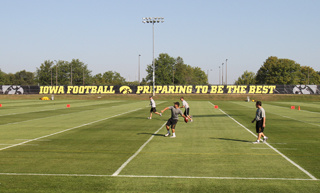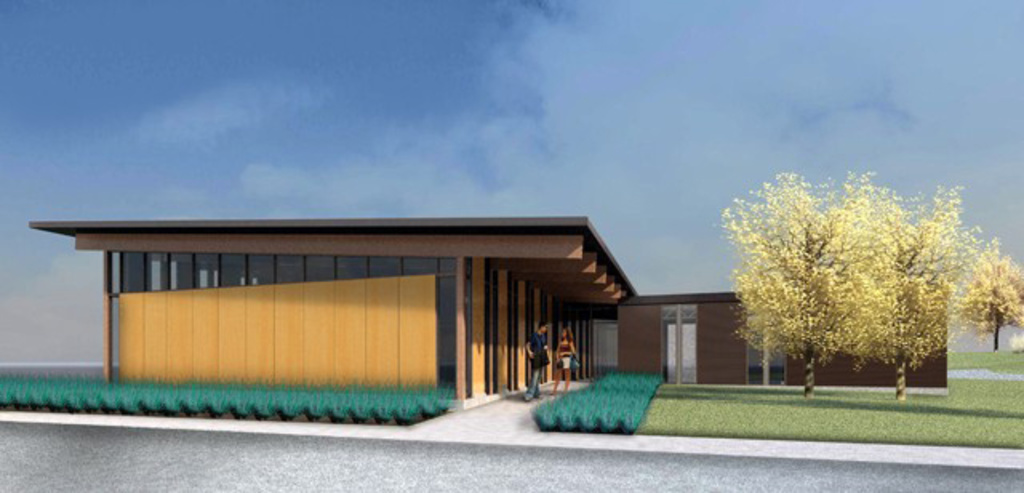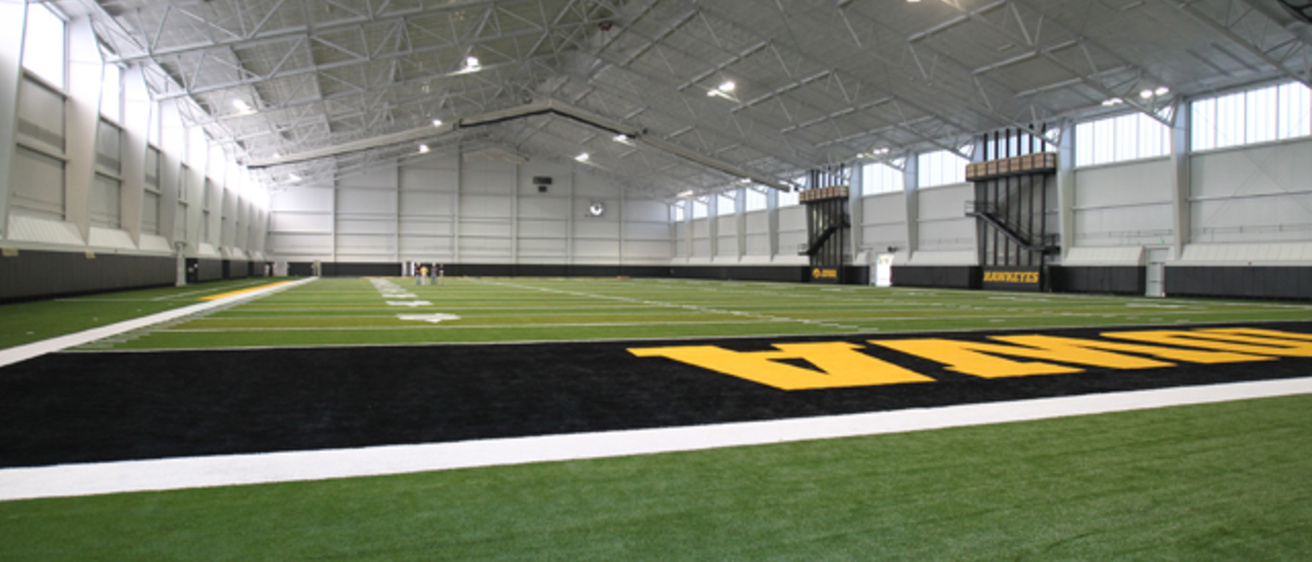Since the beginning of construction in March, University of Iowa head football coach Kirk Ferentz has watched the new football practice facility take shape. As the finishing touches were applied, he was in awe.

"I walked out last week and the sun was going down, and it struck me what a beautiful building it is," says Ferentz while meeting with the media on a summer afternoon inside the atrium of the Hayden Fry Football Complex. "It looks good on the inside, it looks good on the outside, and it is something our players are really going to benefit from in the short term and that's what it is all about."
The 102,000-square-foot facility, which features 45-foot high side walls and 65-foot clearance at the peak, was completed in August, providing Iowa with a practice venue to compete with any program in the Big Ten Conference. It has a 100-yard indoor facility with FieldTurf, three filming platforms, and goalpost netting.
The $55 million facility upgrade also has outdoor grass fields available north of the facility and outside FieldTurf inside Kinnick Stadium.
That's a step up from the recently deflated 27-year old Bubble.
The new facility had the Hawkeye players buzzing.
"We want to build facilities where our team can compete for the best athletes, and we know how important the facilities are to getting the best athletes. When it comes down to recruiting, we want to make sure that we have the facilities that compete within the Big Ten, and we believe this facility does."
—Jane Meyer,
UI senior associate athletics director
"Anything would beat the Bubble," says junior safety Tanner Miller. "On 95- or 100-degree days, it was a nightmare in there. Having these new facilities is pretty cool, not just for us, but as a recruiting tool.
"I've heard a few guys that have gone in there and looked around a little bit, and I've heard all great things. They said it is going to be massive, and we're all pretty excited about it."
While junior Anthony Hitchens is excited to take advantage of the facility as a player, he knows what kind of doors it will open in the world of college football recruiting.
"It's going to give recruits a better look at our program," says Hitchens, a linebacker from Ohio. "It is going to bring in more recruits, and when it is finished it should be a really nice facility."
UI senior associate athletics director Jane Meyer says the Hawkeyes needed to invest in a facility to allow the coaches to better compete on the recruiting trail.
"We want to build facilities where our team can compete for the best athletes, and we know how important the facilities are to getting the best athletes," says Meyer, while leading a facility tour with the Iowa media. "When it comes down to recruiting, we want to make sure that we have the facilities that compete within the Big Ten, and we believe this facility does."
Deflating "the Bubble"
The new era meant that the “Bubble” training facility would no longer be used. Permanent deflation of the Bubble began at 9:30 a.m. Friday, April 20, and finished nearly 30 minutes later.
"From an athletics perspective, we always dream to the future," says Meyer. "(The Bubble) has gone beyond its lifespan. What we're excited about is what it provides with closer parking and transportation, parking for our folks who work at UIHC, but more importantly, we have a more durable facility that helps us from an energy perspective. The new football building being built on the Kenyon Football Practice Facility is a much more energy-efficient facility."
All the material from the Bubble will be repurposed by a subcontractor, including the turf inside the building.
For 27 years, the Bubble served as an indoor practice facility for several UI athletics teams, but its primary use was by the football program. From 1985 to 1998, the structure deflated twice as a result of natural causes: a blizzard in December 1990, and a storm in June 1998. It was flattened Friday by opening four exterior doors and turning off blowers that forced air inside and kept the tarp roof up.
"Some people are very sad because this has been a facility that has been very good to all of our sports teams, primarily football," Meyer says. "This is a great move to our future."
Phase II moves forward
The Board of Regents, State of Iowa, on April 26 approved plans for the second and final phase of a facilities plan for the football program at the University of Iowa that will assist in the recruitment, retention, and performance of its student athletes.
"This is a very exciting day. This next step in facility improvements for our football program has been part of a master plan launched several years ago with the renovations of Kinnick Stadium and Carver-Hawkeye Arena. This is the next critical step to the plan," says Gary Barta, UI director of athletics.
Take a look at floor plans for the Football Operations Facility:
First level
Mezzanine
The Football Operations Facility will connect to the Indoor Practice Facility. The timing of the construction of the indoor practice space and the operations facility are necessitated by the construction of the new UI Children's Hospital, and the construction of a new west campus Cambus hub and associated office and operations space for UI Parking and Transportation.
The operation facility will have two levels. The lower level will include strength and conditioning space, locker rooms for student-athletes and coaches, a lobby and entertainment space that will sport the look and feel of a hall of fame, sports medicine space, and space for equipment distribution and maintenance.
The mezzanine level will include team and position meeting rooms, office space and conference rooms for members of the coaching and administrative staffs, multi-purpose recruiting space, and space for video operations.
The structure of the operations facility will be a steel-framed building designed to create a column-free strength training and conditioning space to enhance safety and future flexibility. The exterior will consist of brick and cast stone similar to the materials used on the exterior of historic Kinnick Stadium.
Construction of the operations facility is expected to begin in earnest next spring; completion is anticipated in the summer of 2014. The budget for the project is $36.6 million and will be paid for entirely by the UI Athletics Department through the Iowa Football Legacy fundraising campaign and other department revenues. No general university financial support or increased UI student fees will be used as a revenue source for financing the project or to fund its future operation and maintenance.

Golf's new home in full swing
Completing a job without the necessary tools can be a challenge. It can be done, but creativity is required to overcome certain hurdles.
For the University of Iowa men's and women's golf teams, those hurdles include cold temperatures, snow, and damp springs.
UI men's golf head coach Mark Hankins and UI women's golf head coach Megan Menzel had to find ways to practice during those cold winter months and soggy spring afternoons. Golf courses and driving ranges are nowhere near ready for use and Iowa winters aren't conducive to golf.
Now that construction on the new Varsity Golf Complex at Finkbine is under way, the hours spent on planning creative practice plans can now be spent on improving actual swings.
The Varsity Golf Complex will overlook hole No. 6 at Finkbine and will be the new home of Iowa golf. The facility will include a 3,150-square-foot putting green that can be modified like a natural grass green, effectively recreating an outdoor putting surface. It will also have a 1,200-square-foot performance studio featuring the V-1 Video Swing Analysis System, allowing players to digitally record, analyze, and compare their swings to professionals to learn from the best in the world.
The performance studio will include indoor heated hitting bays that open to the driving range, enabling student-athletes to work on full swing mechanics throughout the entire year. Locker rooms, offices, and lounge spaces for both teams will be available once the facility is completed in February 2013.
During the winter months or in inclement weather, Iowa golfers didn't have a place to hit full shots. Instead, they would hit into nets or maybe hit 120-yard wedges in the Bubble. The Varsity Golf Complex will give student athletes a chance to work on their entire game any day of the year.
Hankins understands the role weather can play in college golf, and the national rankings are a good explanation.
"Traditionally a lot of Big Ten teams are ranked highly after the fall season," Hankins says. "The one thing southern schools don't like to talk about is how good our fall weather is.
"This facility will be huge for us when it comes to recruiting. We are putting together a first-class facility and a great training center for our golfers."
—Megan Menzel, head coach, women's golf
"In the spring, the Big Ten schools start to fall down the leaderboard," Hankins says. "It has to do with the preparation level and amount of time spent in inclement weather. Having a new facility like this not only gives us the chance to practice in the winter, but during rainy days in the spring as well."
Both coaches are frequently asked what exactly they do for training during the winter and early spring months. Now they can showcase a state-of-the-art facility to potential student athletes to answer the question.
"This facility will be huge for us when it comes to recruiting," Menzel says. "We are very fortunate to have Finkbine so close to campus. This completely enhances that with all of the amenities. We are putting together a first-class facility and a great training center for our golfers."
"One of the things recruits are looking for is the ability for a program to help them make it the PGA Tour," Hankins says. "You can't do that unless you have the proper facilities to teach them, and they can work on their game every day. This new facility gives us that opportunity."
Weather isn't the only thing the facility allows Iowa golfers to avoid. Daylight is no longer a worry.
"Say a player has a test or class commitment at 3 p.m. and needs to miss practice," Hankins says. "He can come in the facility at 11 p.m. at night if he wants and practice as long as he wants. It allows kids who want to work harder than anyone in the country the opportunity to make it to the highest level."
Any golfer knows that the short game is the most important aspect of the sport. The new short game room at the Varsity Golf Complex gives Iowa golfers a chance to chip out of simulated greenside rough and fringe, along with a massive putting surface that can be manipulated daily.
"Short game is the biggest part of the game where we want to see improvements," Menzel says. "The chipping and putting room right at our players' fingertips will be phenomenal."
The V-1 Video Swing Analysis System is used by the top professional players in the world. Iowa golfers will be able to use that technology every day at Finkbine.
"Some of the technology we have in this building is second-to-none," Hankins says. "We are going to have the best golf facility in the state of Iowa. That's not just on the college level, that's across the entire state. We need that because we have the best players in the state of Iowa."
